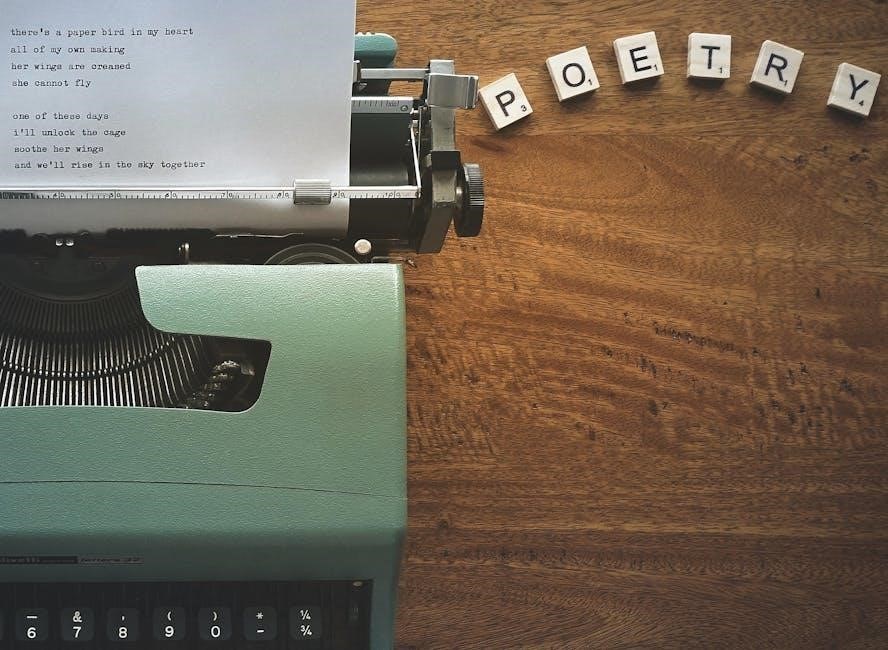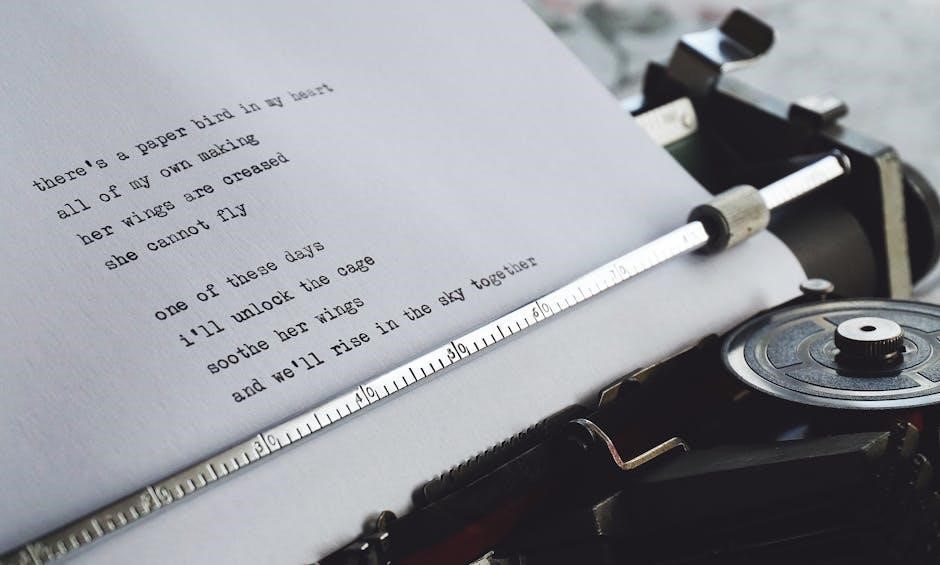The poem Yourself to Blame explores themes of personal responsibility and guilt through a reflective and emotionally charged narrative, offering insights into self-accountability and societal expectations.

1.1 Overview of the Poem’s Theme
The poem Yourself to Blame delves into themes of personal responsibility and self-reflection, emphasizing the consequences of one’s actions. It explores the idea that individuals must often confront their own culpability in life’s challenges. Through its narrative, the poem highlights the human tendency to shift blame outward, urging readers to introspect and acknowledge their role in their circumstances. This theme is universal, resonating with audiences by encouraging accountability and self-awareness in the face of adversity.
1.2 Historical Background and Context
The poem Yourself to Blame emerges from a period marked by global crises, including the COVID-19 pandemic, which prompted widespread introspection. Written during lockdowns, it reflects on personal and societal struggles, mirroring the era’s emotional turmoil. The poem’s themes of guilt and responsibility resonate with the collective experience of navigating unprecedented challenges, making it a poignant reflection of its time. Its context underscores the universal relevance of self-reflection and accountability in the face of adversity.

Structure and Style
The poem features a rhythmic flow with a musical quality, enhanced by its rhyme scheme, making it memorable and engaging. Its structure blends simplicity with depth, ensuring accessibility while conveying profound themes effectively.
2.1 Rhyme and Rhythm in the Poem
The poem employs a consistent rhyme scheme, creating a melodic flow that enhances its readability. The rhythm is steady and predictable, contributing to its musical quality. This structure makes the poem accessible and engaging, particularly for younger readers, while emphasizing its themes of personal responsibility. The rhyme and rhythm work together to create a sense of inevitability, mirroring the poem’s message about accountability. This harmonious blend of sound and sense underscores the emotional depth of the narrative, making it both memorable and impactful.
2.2 Use of Meter and Cadence
The poem Yourself to Blame features a steady meter that enhances its rhythmic cadence, creating a natural flow reminiscent of musical composition. This rhythmic structure not only adds to the poem’s readability but also emphasizes its themes of accountability and self-reflection. The cadence, though subtle, carries an emotional weight, mirroring the introspective tone of the narrative. This harmonious interplay of meter and cadence makes the poem both engaging and impactful, allowing readers to connect deeply with its message of personal responsibility.
2.3 Literary Devices Employed
The poem Yourself to Blame employs a range of literary devices to convey its themes effectively. Metaphor and simile are used to illustrate personal struggles, while alliteration and assonance enhance its musicality. Symbolism plays a key role in representing guilt and responsibility, adding depth to the narrative. The use of imagery creates vivid scenes that resonate emotionally with readers. These devices collectively enrich the poem’s emotional impact and thematic complexity, making it a compelling exploration of human accountability and introspection.

Themes Explored in the Poem
The poem delves into guilt, self-reflection, and accountability, emphasizing personal responsibility and the consequences of one’s actions, while also addressing societal expectations and individual blame.
3.1 The Concept of Guilt and Responsibility
The poem explores the emotional weight of guilt and the importance of taking responsibility for one’s actions. It highlights how individuals often bear the blame for their circumstances, emphasizing moral accountability. Through vivid imagery and introspective language, the poem conveys the idea that guilt can serve as a catalyst for self-reflection and personal growth. This theme underscores the human tendency to look inward when faced with regret, urging readers to acknowledge their role in shaping their own destinies and embracing responsibility as a path to redemption.
3.2 The Idea of Self-Reflection and Accountability
The poem delves into the importance of self-reflection, urging readers to examine their actions and decisions. It suggests that true accountability begins with introspection, where individuals confront their flaws and mistakes. The narrative emphasizes that personal growth stems from owning one’s errors, rather than shifting blame. Through its lyrical tone, the poem encourages a deeper understanding of oneself, highlighting the transformative power of acknowledging and learning from past missteps. This theme resonates universally, inviting readers to embrace accountability as a path to self-improvement and emotional freedom.
3.3 Societal Expectations and Individual Blame
The poem critiques the tension between societal expectations and individual blame, illustrating how external pressures often lead to self-culpability. It explores how societal norms can influence personal decisions, causing individuals to internalize guilt for circumstances beyond their control; The narrative suggests that breaking free from these expectations requires self-awareness and the courage to challenge societal constructs. By addressing these dynamics, the poem encourages readers to question external influences and take ownership of their choices, fostering a sense of liberation from undue blame and fostering personal empowerment through self-reflection and understanding.

The Author’s Background
Rebecca Lindenberg, a writer and educator, authored Yourself to Blame, reflecting her expertise in poetry and storytelling, as seen in her works like The Logan Notebooks.
4.1 Biography of the Poet
Rebecca Lindenberg, the author of Yourself to Blame, is a celebrated poet, educator, and editor. Born in the United States, she developed a passion for literature early in life, pursuing degrees in creative writing. Her work often explores themes of identity, morality, and human struggle, resonating deeply with readers. Lindenberg’s poetic style is characterized by its emotional depth and introspective nature, drawing from her experiences as a writer and educator. Her contributions to literature have earned her recognition and acclaim in both academic and literary circles.
4.2 The Poet’s Other Works and Contributions
Rebecca Lindenberg’s notable works include Our Splendid Failure to Do the Impossible and The Logan Notebooks, showcasing her versatility as a poet. Her writings often delve into themes of identity, morality, and human resilience, resonating with a wide audience. Beyond poetry, Lindenberg contributes to literature as an educator and editor, fostering emerging voices and enriching the literary community. Her work continues to inspire readers and writers alike, solidifying her reputation as a meaningful contributor to contemporary poetry.
4.3 Influences on the Poet’s Writing Style
Rebecca Lindenberg’s writing is influenced by her deep engagement with societal issues and personal introspection. Her poetic style reflects a blend of lyrical and narrative techniques, enriched by her experience as an educator. The emotional depth in her work, as seen in Yourself to Blame, suggests an influence from both classical poetry and modern storytelling. Her ability to weave complex emotions into accessible verse underscores her unique voice, shaped by a mix of literary traditions and contemporary themes.

Cultural and Historical Significance
The poem addresses universal themes of guilt and responsibility, resonating across cultures and time, while its historical context, including the COVID-19 pandemic, adds depth to its relevance today.
5.1 The Poem’s Relevance in Modern Times
The poem’s exploration of personal responsibility and guilt remains highly relevant today, as modern society grapples with self-reflection and accountability in the face of global challenges like the COVID-19 pandemic. Its themes of introspection and the consequences of one’s actions resonate deeply in a world where individuals are increasingly called to examine their roles in societal issues. The poem’s message encourages readers to take ownership of their decisions, making it a timeless piece that continues to inspire self-awareness and growth in contemporary times.
5.2 The Role of Poetry in Social Commentary
Poetry serves as a powerful medium for social commentary, offering insights into societal issues through emotional and introspective narratives. Yourself to Blame exemplifies this by addressing themes of personal responsibility and guilt, encouraging readers to reflect on their actions and their impact on the world. The poem’s ability to provoke thought and spark self-awareness highlights poetry’s enduring role in fostering dialogue and driving change, making it a vital tool for addressing contemporary challenges and inspiring collective growth.
5.3 The Poem’s Place in Educational Curricula
The poem Yourself to Blame holds significant value in educational settings due to its exploration of universal themes such as guilt, responsibility, and self-reflection. Its accessible language and relatable imagery make it an ideal tool for teaching critical thinking and emotional intelligence. Educators often incorporate such works to encourage students to analyze complex emotions and societal expectations. The poem’s concise structure and profound message make it a valuable addition to literature curricula, fostering meaningful discussions and deeper understanding of human experiences.

Analysis of Key Stanzas
The poem’s central stanzas delve into themes of guilt and self-reflection, using rhythm and rhyme to convey a profound exploration of personal accountability and emotional depth.
6.1 Breakdown of the First Stanza
The first stanza of Yourself to Blame introduces themes of guilt and self-reflection through vivid imagery. It sets the tone by questioning actions and their consequences, urging readers to confront their own accountability. The language is simple yet profound, emphasizing personal responsibility. The stanza’s structure and rhythm create an emotional flow, drawing the reader into a journey of introspection. This opening section lays the foundation for the poem’s exploration of blame and its impact on individual lives.
6.2 Interpretation of Central Imagery
The poem’s central imagery revolves around reflections and shadows, symbolizing guilt and self-examination. These images evoke a sense of introspection, urging readers to confront their past actions. The use of light and darkness contrasts innocence with regret, highlighting personal accountability. Such imagery creates a vivid emotional landscape, reinforcing the theme of self-blame and the consequences of one’s choices. This visual storytelling enhances the poem’s emotional depth and resonates with its message of personal responsibility.
6.3 The Climax and Resolution of the Poem
The poem reaches its climax as the speaker confronts the inevitability of self-blame, acknowledging the consequences of their actions. This turning point emphasizes personal accountability and the futility of external excuses. The resolution offers a message of hope, urging introspection and growth. Through this emotional journey, the speaker and reader are encouraged to embrace responsibility, transforming guilt into a catalyst for change. The poem concludes with a powerful call to self-awareness, leaving a lasting impact on its audience.

Reception and Reviews
The poem Yourself to Blame has received acclaim for its exploration of guilt and responsibility. Its relatable themes resonate with a wide audience, enhancing its impact.
7.1 Critical Reception of the Poem
Critics have praised Yourself to Blame for its profound exploration of guilt and personal responsibility. The poem’s emotional depth and relatable themes have resonated widely, earning it critical acclaim. Many reviewers highlight its ability to provoke self-reflection, while its structured rhyme and rhythm contribute to its accessibility. The work is often commended for its universal appeal, making it a significant piece in contemporary poetry. Its impact lies in its ability to connect with readers on a deeply personal level.
7.2 Audience Responses and Feedback
Readers have expressed a strong emotional connection to Yourself to Blame, praising its relatable themes of guilt and self-reflection. Many find the poem’s structured rhythm and rhyme appealing, making it accessible and memorable. Educators appreciate its educational value, often incorporating it into curricula. The poem’s ability to resonate universally has made it a favorite among diverse audiences. Its exploration of personal responsibility continues to inspire introspection and dialogue, leaving a lasting impact on those who engage with its profound message.
7.3 Comparisons to Other Poems in the Same Genre
Yourself to Blame shares thematic similarities with works by poets like Langston Hughes and Sylvia Plath, who also explore guilt, responsibility, and self-reflection. Its structured rhythm and rhyme resemble Hughes’ accessible style, while its emotional depth aligns with Plath’s introspective narratives. However, the poem’s modern tone and focus on personal accountability set it apart, making it a unique yet relatable piece in the genre. Its universal themes resonate with readers, much like classical poetry, while its contemporary voice appeals to a new generation of poetry enthusiasts.

The Title’s Significance
The title Yourself to Blame encapsulates the poem’s central theme of personal accountability, immediately conveying its focus on self-reflection and the consequences of one’s actions.
8.1 The Meaning Behind “Yourself to Blame”
The title Yourself to Blame carries a profound weight, emphasizing personal accountability and self-awareness. It suggests that individuals must confront their own actions and decisions, rather than shifting blame elsewhere. The phrase underscores the idea that true growth and change begin with acknowledging one’s role in their circumstances. This theme resonates universally, inviting readers to reflect on their own lives and the consequences of their choices, making the poem both deeply personal and broadly relatable.
8.2 How the Title Relates to the Poem’s Message
The title Yourself to Blame directly mirrors the poem’s central message of personal accountability and self-reflection. It serves as a call to introspection, urging readers to examine their own actions and decisions rather than external circumstances. This alignment between title and theme creates a powerful framework for exploring guilt, responsibility, and societal expectations. The clarity and directness of the title enhance the poem’s ability to resonate with readers, making its message both accessible and impactful.
8.3 The Impact of the Title on Reader Perception
The title Yourself to Blame immediately sets a tone of introspection and accountability, influencing readers to approach the poem with a mindset of self-examination. Its directness prompts readers to consider their own role in life’s challenges, fostering a deeper engagement with the poem’s themes of guilt and responsibility. This title’s clarity and emotional weight ensure that readers are primed to reflect on their personal experiences, enhancing the poem’s ability to evoke a strong, relatable response from its audience.

The Poem’s Message
The poem conveys a powerful message of accountability, urging readers to recognize their role in life’s challenges and embrace personal responsibility for their actions and outcomes.
9.1 The Central Message of Personal Responsibility
The poem emphasizes personal responsibility as its core message, urging individuals to acknowledge their agency in shaping life’s outcomes. By reflecting on one’s actions and decisions, the speaker highlights the importance of self-awareness and accountability. This theme is reinforced through the exploration of guilt and societal expectations, encouraging readers to take ownership of their choices rather than blaming external circumstances. The poem’s central message resonates universally, making it relatable across diverse experiences and fostering a deeper understanding of individual accountability.
9.2 The Universality of the Poem’s Themes
The poem’s themes of personal responsibility, guilt, and self-reflection are timeless and universal, resonating with readers across cultures and generations. Its exploration of human emotions and accountability transcends individual experiences, making it relatable to a broad audience. The idea that one’s actions have consequences is a shared human experience, allowing readers to connect deeply with the poem’s message. This universality ensures the poem’s relevance in understanding personal and collective challenges, fostering empathy and self-awareness in its readers.
9.3 The Poem’s Call to Action
The poem serves as a powerful call to action, urging readers to embrace personal responsibility and introspection. Through its themes of guilt and accountability, it encourages individuals to reflect on their choices and their impact on others. The poem inspires a mindset of self-awareness, prompting readers to confront their flaws and strive for personal growth. This call to action transcends the poem itself, becoming a catalyst for change and self-improvement in the lives of those who engage with its message.
The poem concludes by reinforcing the importance of personal responsibility and self-reflection, leaving a lasting impact on readers and inspiring meaningful introspection and growth.
10.1 Summary of Key Points
The poem “Yourself to Blame” examines themes of personal responsibility, guilt, and societal expectations, emphasizing introspection and accountability. Its use of rhyme and rhythm creates a memorable, almost musical quality, making it accessible to readers of all ages. Written during the Covid pandemic, the poem reflects on collective challenges and individual blame, offering universal lessons. The central message encourages self-awareness and acceptance of one’s role in life’s outcomes, resonating deeply with readers and inspiring reflection. This concise yet powerful narrative leaves a lasting impact on its audience.
10.2 The Lasting Impact of the Poem
The poem “Yourself to Blame” leaves a lasting impact by addressing universal themes of personal responsibility and guilt, resonating with readers across diverse contexts. Its exploration of self-awareness and accountability fosters deep reflection, making it a meaningful read during challenging times, such as the Covid pandemic. The poem’s memorable structure and emotional depth ensure its relevance, encouraging readers to confront their own roles in life’s outcomes. Its ability to evoke introspection and inspire change solidifies its enduring importance in literary discourse.
10;3 Final Thoughts on the Poem’s Importance
The poem “Yourself to Blame” stands as a poignant reminder of the power of self-reflection and accountability. Its universal themes of guilt, responsibility, and societal expectations resonate deeply, making it a timeless piece for personal and educational contexts. The poem’s ability to inspire introspection and foster empathy ensures its enduring relevance. By addressing human frailty and the need for self-awareness, it offers a profound message that transcends generations, solidifying its place as a meaningful work in literary exploration and personal growth.
